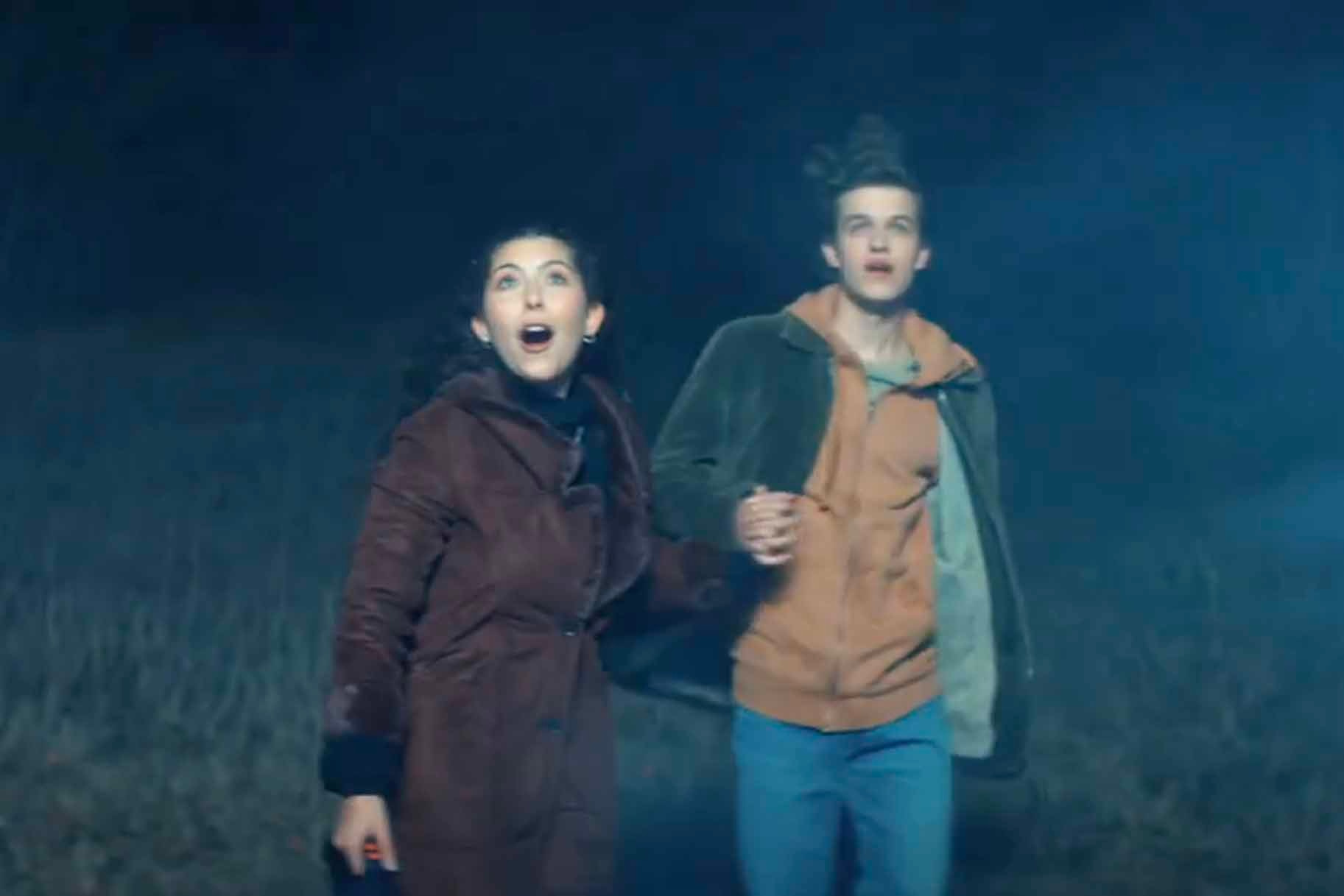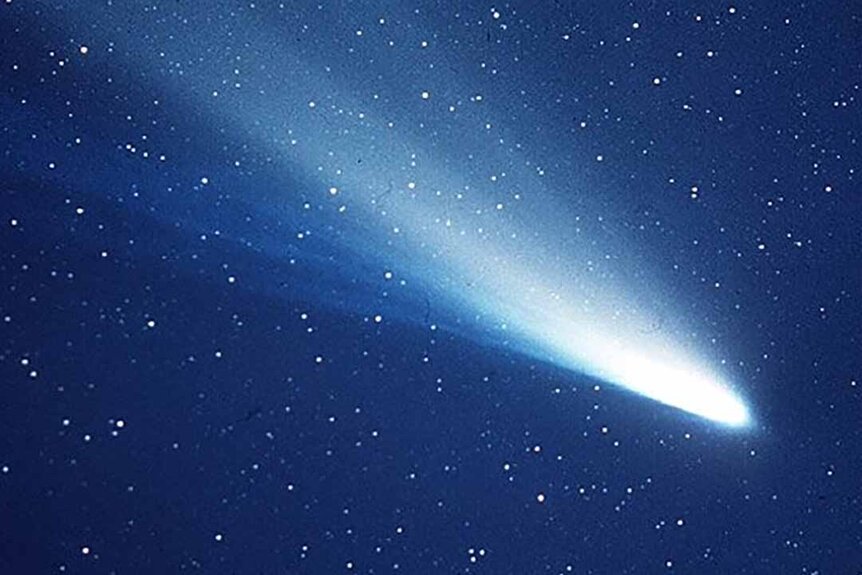Is Comet Jesper from Aliens Abducted My Parents Really Out There?
And does it taste like cotton candy?

Director Jake Van Wagoner’s Aliens Abducted My Parents and Now I Feel Kinda Left Out (streaming now on Peacock) follows the Earthly adventures of Calvin (Jacob Buster) and Itsy (Emma Tremblay), two teenage friends hunting down the truth about Calvin’s parents. As a kid, Calvin was out with his dad one evening, looking through a telescope for the fictional comet Jesper, when both of his parents vanished.
Calvin has spent the better part of a decade learning about Jesper and preparing to be abducted himself when it comes back around for another flyby of Earth. The comet returns approximately every 10 years and Calvin is certain the aliens, and his parents, are coming back too.
The comet first appears within the timeline of the film on October 21, 2012, at precisely 9:44 p.m., which gives us a concrete starting point for finding Jesper. Its return date isn’t clear, but we know it’s roughly 10 years later and we know it’s winter. Just before Jesper comes back in the final act, we get a quick glance at a newspaper bearing a February date. That gives Jesper an orbital period of about 10.3 years. If we’re going to help Calvin find his parents, we need to figure out which comet he’s looking for, without a lot of information to go on.
For More on Comets:
Halley’s Comet Is Headed Back Our Way
"Devil" Comet 12P Grows "Horns" As It Approaches Inner Solar System
A comet is about to pass by Earth for the first (and last) time in 50,000 years
Searching for the Fictional Comet Jesper
Generally speaking, comets are named after their discoverer, which is usually a person or a spacecraft. It’s why you’ll see a whole bunch of comets with similar names, because certain people and spacecraft are really good at finding them. Sometimes, comets are named after the person who calculated their orbit, but that is rarer.
In the real world there is no comet Jesper, but there might be a comet that is Jesper-like. We’ve got two main types of comets to sift through in our search: short period and long period comets. Long period comets are those with orbits over 200 years. Those are right out. These are objects which live much of their lives in deep space, out beyond the orbit of Pluto. The most extreme among them can take thousands or millions of years to orbit the Sun. Calvin would be long dead by the time a long period comet came back around for another pass.
Short period comets are those with orbits under 200 years. The most famous among them is comet Halley, which shows up every 75 years or so. Within short period comets there are two subgroups, the Halley type comets with orbits longer than 20 years, and Jupiter type comets with orbits less than 20 years. We’re looking for a Jupiter family comet with an orbit about 10 years long. We’ve got two known comets that fit the bill: P/2019 S2 and P/2016 A2, with orbital periods of 10.3 and 10.34 years, respectively. If we broaden the range a little, there are another five known comets with a period of 10.3 plus or minus half a year. Those comets are P/2011 W1, P/2020 O3, P/2021 R5, P/2017 D1, and P/2022 M1. And of those, only one, P/2021 R5, would have appeared at around the right time.
The comet P/2021 R5 is a 19th magnitude (magnitude is a measure of apparent brightness, and the higher the number, the dimmer it is; the Moon has a magnitude of -12.6) object with an orbit that carries it between Jupiter and Earth roughly every 10 years. At its last closest approach with Earth, it got within 3.3 AU (short for astronomical unit, the average distance between the Earth and Sun, approximately 93 million miles) from Earth. For context, Halley’s comet will be only 0.5 AU from Earth when it returns in 2061. P/2021 R5 has roughly the orbital period we’re looking for and it made its last approach in January 2022. It isn’t a perfect match for Jesper but it’s about as close as we can get for now.
Sugary Comets, a Sweet Treat for Aliens?
By the time the credits roll on Aliens Abducted My Parents and Now I Feel Kind of Left Out, we’ve learned a few things about Calvin’s parents. Namely that his mom ran out on him as a kid, but his dad really did get abducted. Over the last 10 years of Earth time, his dad has spent 109 years of space time chasing Jesper’s tail with extraterrestrials because, apparently, it tastes like cotton candy.
Bonus Fact: In order for him to have experienced 109 years while an observer on Earth (Calvin) experienced only 10, he must have been traveling faster than 185,496 miles per second, more than 99% the speed of light.
Comet tails are made up of gas and dust being shorn away by the radiation pressure of the solar wind. Out in the colder parts of space, those comets are icy balls of frozen construction materials left over from the formation of the solar system. As they approach the Sun they start to interact with solar radiation and drip cometary sweat in tails trailing behind them. In fact, comets actually have two tails made up of different things, through different processes. The dust tail is made of tiny particles about the same size as particles of smoke, while the plasma tail is made of ionized gas interacting energetically with the solar wind.
These tails can extend for millions of miles through space, pointing away from the Sun like hair being blown back in the wind. Much of the tails are surrounded by an envelope of neutral hydrogen, probably derived from water molecules broken up by solar radiation. Could that strange cosmic environment taste like cotton candy? Maybe!
The ion tails are typically made up of ionized carbon monoxide, molecular nitrogen (two nitrogen atoms bound together) and carbon monoxide. While comets themselves are usually made up of water, methanol, ethane, and hydrogen cyanide, which sounds like a party, but not the cotton candy kind of party. However, astronomers have found evidence of simple sugars like ribose in some meteorites and, in 2015, astronomers discovered that comet Lovejoy (pictured above) is releasing another simple sugar called glycolaldehyde, alongside the equivalent of 500 bottles of wine per second.
On the surface, Calvin’s (out of this) worldview might seem silly, but it turns out that in the movie and in the real world, he might be onto something.
Watch Aliens Abducted My Parents and Now I Feel Kind of Left Out, streaming now on Peacock.

























